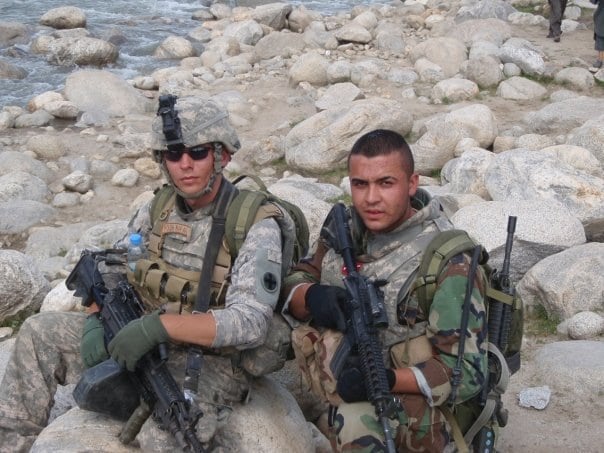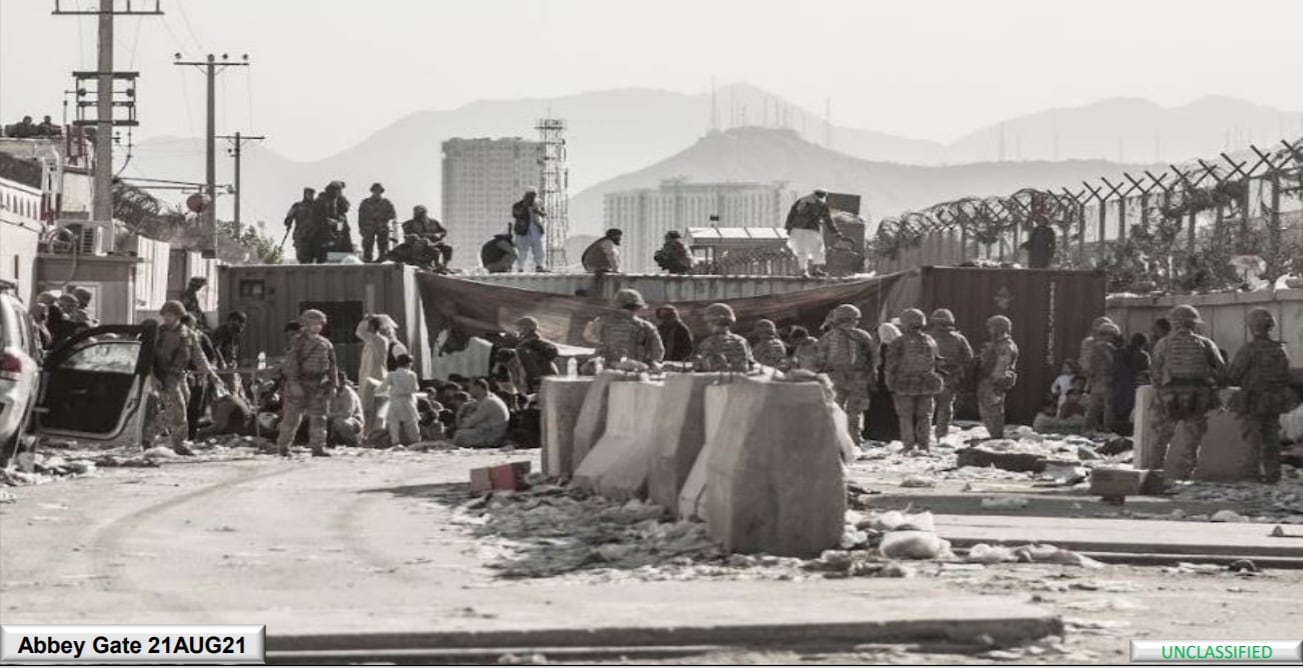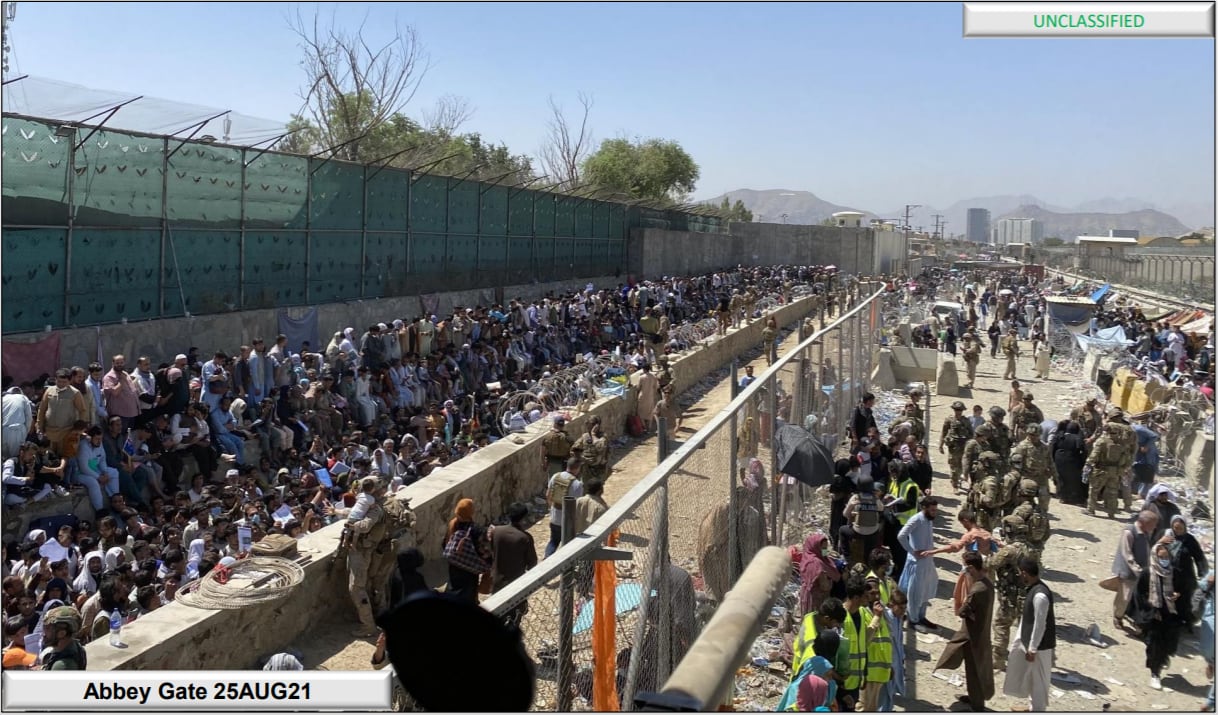ARLINGTON, Virginia ― No one was shot following the Aug. 26, 2021, bombing at Hamid Karzai International Airport in Kabul that resulted in the deaths of 13 U.S. service members and at least 170 Afghan civilians, according to the U.S. military’s investigation into the attack released on Friday.
That finding contradicts initial reports that found the bombing of Abbey Gate was followed by an attack by two gunmen.
“The investigation found that a single explosive device killed at least 170 Afghan civilians and 13 U.S. service members by explosively directing ball bearings to a packed crowd and into our men and women at Abbey Gate,” Marine Corps Gen. Kenneth F. McKenzie Jr., commander of U.S. Central Command, said Friday at the Pentagon.
“The investigation found no definitive proof that anyone was ever hit or killed by gunfire, either us or Afghan.”
RELATED

Though more than 100 people were interviewed throughout the investigation, none were Afghan witnesses who were present and survived the bombing, Army Brig. Gen. Lance Curtis told reporters on Friday.
Gunfire did take place immediately after the bombing, but the investigation described it as “warning shots” that did not hit anyone.
U.S. withdrawal
In mid-August 2021 the Taliban was quickly sweeping across Afghanistan in the face of U.S. military withdrawal from the country.
On Aug. 13, 2021, Marines deployed with the 24th Marine Expeditionary Unit, 2nd Battalion, 1st Marines, and from Bahrain’s Task Force 51/5, along with U.S. soldiers from the 82nd Airborne Division and British troops from the 2nd and 3rd Parachute Regiment, started arriving at Hamid Karzai International Airport in Kabul.
As the Taliban conquered more and more territory, Afghans fearing a Taliban-ruled Afghanistan fled to the airport in hopes of finding one of the last flights out.
Desperate Afghans took over the airport, some even clinging to the outside of a U.S. Air Force C-17 Globemaster III as it took off, falling to their deaths.
U.S. and British forces were used to bring some order to the chaos and to start processing Afghans for evacuation from the country.
The U.S. military started working with the Taliban, now in charge of the country, to process Afghans looking to evacuate.
Outside of Abbey Gate the initial security check, known as the chevron, was manned by Taliban forces, Marine Lt. Col. John Naughton said Friday.

But as time went on, the Taliban started to become more hostile, letting fewer people through. There was at least one report of a Taliban fighter stabbing a minor trying to get to Abbey Gate, according to the U.S. investigation.
In the face of Taliban hostility, those hoping to evacuate started using a sewage canal that ran alongside the airport to reach U.S.-manned security gates.
There, Marines from 2nd Battalion, 1st Marines, would pull people out of the ever-growing crowd and start the evacuation process.
As days went on, the crowds kept growing. But, according to the investigation, in the face of the chaos the Marines kept discipline.
The situation changed dramatically over a short time period, Curtis said.
One video shown to reporters Friday showed a Marine get pulled into the crowd by the muzzle of his rifle barrel. Marines in the area were able to safely pull the grunt back to his feet and out of the crowd without firing a shot.
Army Lt. Gen. Ronald Clark said, “Rather than using deadly force or force really of any kind, the Marines showed great restraint, discipline and courage by just retrieving their teammate from the crowd and moving on.”

Aug. 26, 2021
On Aug. 26, 2021, at about 5 p.m. local time, Brig. Gen. Farrell Sullivan, the joint task force commander at the airport, along with the 24th MEU command and the 82nd Airborne commander, met at Abbey Gate with representatives of the British military and the Taliban to share intelligence about the ongoing security situation.
During that discussion the topic of closing the gate came up, particularly in the light of a potential suicide attack.
Curtis did not say whether a decision to close the gate or leave it open was made during this discussion.
But, the gate remained open.
Roughly 36 minutes later a suicide bomber with about 20 pounds of explosive strapped to his chest set off a bomb in the canal where thousands of Afghans were waiting.
Hundreds of 5 mm ball bearings ripped through the crowd and U.S. service members, who were searching Afghans just meters away.
Three of the U.S. service members killed were just three meters away from the bomber, said Army Lt. Col. Bert Smith. The furthest service member to die from the blast was almost 17 meters away.
In total 11 U.S. Marines, one Navy corpsman and one soldier were killed in the blast.
The names of the dead are: Staff Sgt. Darin T. Hoover, 31, with 2nd Battalion, 1st Marine Regiment, out of Camp Pendleton, California; Sgt. Johanny Rosario Pichardo, 25, with 5th Marine Expeditionary Brigade, Naval Support Activity Bahrain; Sgt. Nicole Gee, 23, with Combat Logistics Battalion 24, 24th Marine Expeditionary Unit; Cpl. Hunter Lopez, 22, with 2nd Battalion, 1st Marine Regiment; Cpl. Daegan W. Page, 23, with 2nd Battalion, 1st Marine Regiment; Cpl. Humberto A. Sanchez, 22, with 2nd Battalion, 1st Marine Regiment; Lance Cpl. David L. Espinoza, 20, with 2nd Battalion, 1st Marine Regiment; Lance Cpl. Jared M. Schmitz, 20, with 2nd Battalion, 1st Marine Regiment; Lance Cpl. Rylee J. McCollum, 20, with 2nd Battalion, 1st Marine Regiment; Lance Cpl. Dylan R. Merola, 20, with 2nd Battalion, 1st Marine Regiment; Lance Cpl. Kareem M. Nikoui, 20, with 2nd Battalion, 1st Marine Regiment; Navy corpsman Maxton W. Soviak, 22, assigned to 1st Marine Regiment, 1st Marine Division, Camp Pendleton, California; and Army Staff Sgt. Ryan C. Knauss, 23, assigned to 9th PSYOP Battalion, 8th PSYOP Group, Ft. Bragg, North Carolina.
Autopsies found injuries from ball bearings as the cause of death for every U.S. service member killed.
No amount of medical care could have saved any of the service members who were killed because of the bomb, according to the investigation.
“The wounds sustained by the killed in action at Abbey Gate were so catastrophic that none could be saved,” Curtis said.
In total 45 U.S. service members were wounded in the attack, Smith said.
One of the wounded Marines was Lt. Col. Brad Whited, commander of 2nd Battalion, 1st Marines, Curtis said.
The initial reports of gunshot wounds likely came from how closely a ball bearing wound resembles a gunshot wound, McKenzie said.
Following the blast two group of British troops fired an estimated 25 to 30 rounds as warning shots over the crowd, hoping to disperse the crowd.
One group of Marines fired four warning shots at a man they said was acting aggressively, according to the investigation. The man fled after the Marines opened fire.
Another group of Marines further from the blast fired an unknown number of shots at an Afghan they said was aggressively holding an AK-47 while standing on a watch tower that overlooked the scene, Marine Col. C.J. Douglas said.
“Although the Marines did not see him fire, they believed he exhibited hostile intent,” he said.
The British gunfire passing in front of the Marines may have affected their belief of the man’s hostile intent, Douglas said.
None of the Marines saw their shots hit the man or anyone else.
Echoes from the warning shots and the fog of war that took hold immediately after the blast were the likely cause of the initial reports that the bombing was followed up by gunmen, Douglas said.
“The blast created instant chaos and sensory overload,” Douglas said.
Despite the chaos and the tragedy Curtis backed all the decisions made by commanders at Abbey Gate that day.
“Based on our investigation, at the tactical level, this was not preventable,” Curtis said.




